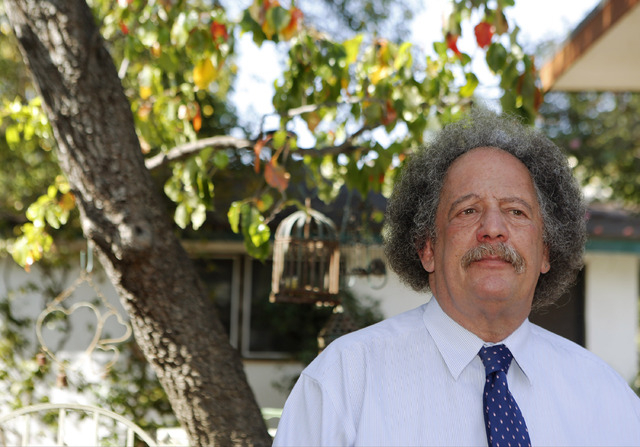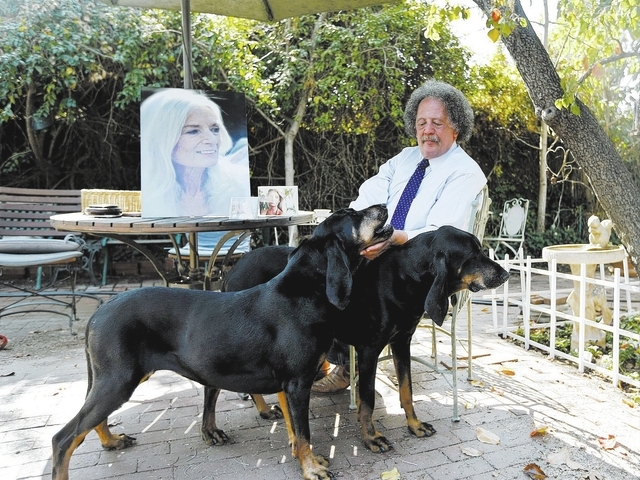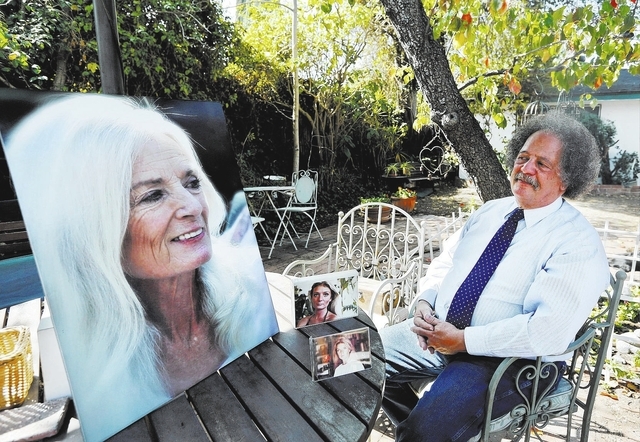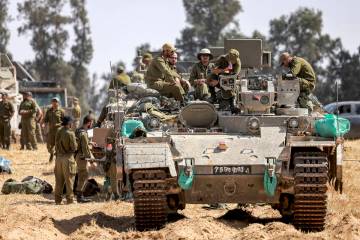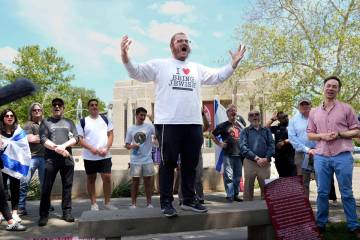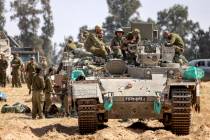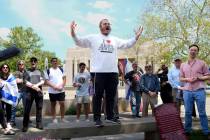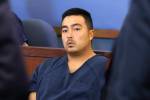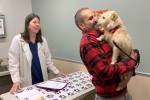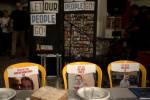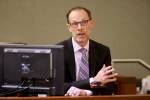Wife’s death one too many for hospice nurse
LOS ANGELES
Jay Westbrook’s cowboy boot is planted firmly on the gas pedal of his shiny black pickup. Everywhere he turns, a memory flashes.
In Van Nuys, it is the lifeless little girl he held at Valley Presbyterian Hospital after she was found in the bottom of a hot tub. Near Beverly Hills, outside a Wilshire Boulevard high-rise, it is the old woman in a seven-figure condo whose misery he tried to soothe. On Skid Row, it is the 29-year-old crack addict he brought morphine to numb the pain of cancer, as she died in a box on the street.
There have been thousands of them, thousands of souls he journeyed with to the intersection of living and dying, who helped establish him as one of the foremost experts on care in a patient’s final days. Thousands of moments, tender and haunting and sweet, that rush back to him. Thousands of deaths that collectively formed his life.
It might have gone on this way forever, the never-ending string of deathbed confessions and last breaths and tear-soaked eulogies. Then came one death too many.
■ ■ ■
The first time was a cluster of machines and tubes, and breaths shallow and panting. Westbrook was a student nurse, the patient a big man, maybe 6 feet 4 inches, so swollen from cirrhosis it looked as if he was pregnant with triplets. His mustache was trimmed, his flattop prematurely white. Westbrook had cared for the man for several weeks, and when the time finally came, a profound sadness drove him to tears.
He felt powerless and mortal; and for the first time, this product of atheist parents felt something more.
“I had that experience of the place where life and death meet being filled with God,” he said.
In the two decades that followed, Westbrook experienced more deaths than he could count — as a cancer nurse, in pain management and, most of all, in hospice. He’d put 50,000 miles on his truck some years, driving from one dying person’s house to another. Some nights, he’d balance three deaths.
Many cases were both singular and similar. Those who survived a brush with death — by electrocution or shooting or drowning, perhaps — reported traveling down a tunnel toward a bright light. Those whose age or disease brought a more gradual exit often experienced visions of a loved one who went before, as well as a day of seemingly stunning turnaround, where lucidity returned and pain subsided and all, for a short time, seemed well. It could be a cruel tease to those praying for a miracle, as it was generally followed by clues the end was near: mottled skin, cold extremities, rolled-back eyes and breathing that sounds like a locomotive leaving the station.
Through it all, he was sustained by love.
■ ■ ■
They met on June 7, 1968, at a party bidding Westbrook farewell before he was to leave California to teach reading in Appalachia. Two young women arrived dragging an unenthusiastic third to whom he was soon introduced.
“Nancy, this is Jay,” the host said. “Jay, this is Nancy.”
She wanted to take a walk on the beach, and Westbrook accompanied her. They took the footbridge over the Pacific Coast Highway, walking and talking for hours and coming to rest on the sand.
“Six hours later, the sun came up and we were in love,” Westbrook said.
He never went to Appalachia. He was smitten with her sensitivity, her humility, her long, golden hair. Before long, Nancy Morgan was Nancy Westbrook. They lived modestly but joyfully.
■ ■ ■
Jay is 67 now, white flecked in his wispy bush of hair, a gold Alcoholics Anonymous pendant around his neck. The scars of a deeply troubled childhood — he was largely abandoned by his birth parents, raped by other family members, seriously contemplated suicide — are so deep he still sleeps with a night light to ward off a lasting fear of the dark. They helped stir in Westbrook a strain of empathy so strong he became irreplaceable at the worst moment in others’ lives.
“My suffering,” he said, “became my vehicle for awakening compassion in me.”
A nursing degree brought him where he wanted to be. He became a luminary of the end-of-life world, not just because of his skill, but because he told the stories of his work with such eloquence it enthralled audiences, from medical students in a Harvard lecture hall to hospice workers filling a conference room. He went to ground zero in New York and to a prison death chamber in Louisiana, and day after day, he went back to the bedside of the dying.
It was deeply fulfilling, but draining work. Nancy not only helped her husband deal with the depths of his past, but also the daily trials of death. Sometimes, when he arrived home from a tough day, he’d put his head on her chest and listen to her heart beat. They’d play with the dogs, talk about their days, discuss lessons learned from the dying.
Time and again, he saw a deathbed full of regrets. It taught him and Nancy to never part without an embrace and an expression of love. Tomorrow, he knew, was not guaranteed.
■ ■ ■
It was Monday — Dec. 12, 2011 — when Nancy first awoke in pain. On Tuesday, it worsened. On Wednesday, she saw the doctor. On Thursday, she had a CT scan. On Monday, she had surgery. And on Tuesday, the diagnosis came: pancreatic cancer.
The doctors said she probably had four months to live with no intervention, up to a year with aggressive chemotherapy. Westbrook had had hundreds of pancreatic cancer patients before and expected she had seven months. Four days shy of that, she awoke feeling great, free from pain and full of energy — the cruel pre-death rally he’d seen so many times before. In the yard, she asked him to lift her up, and she put her head on his chest.
“I love you,” she said, emphatically.
Before long, her skin became mottled, her extremities cold, her breathing strained. He knew the end was near and, though they didn’t speak of it, he suspects she did, too. She wanted to stay outside in her beloved garden. And late into the night, they sat. She kept resisting going in to bed, but when they finally did, Nancy mustered her last words.
“I love you,” she said again. “Goodnight.”
By morning, she had lost consciousness. He took her in his arms and held her close.
“Sweetheart, I love you so much, I will miss you so much when you’re gone, but I’ll be OK,” he said. “And if and when you’re ready, you have my permission to go.”
Ninety seconds later, it was over.
And now, Westbrook knew, his career was too.
■ ■ ■
It has been nearly two years since he buried Nancy beneath a pear tree that rains pink flowers. He hasn’t attended to another patient since. He carries the same picture of her in his wallet and keeps the same greeting on their voice mail.
He speaks of her in the present tense. He speaks of his career in the past.
“I’ve lost my life and I’ve lost my work,” he said.
So many of his patients died with such certainty on where they were going next, but all these years of death brought him no closer to knowing whether he’ll ever see Nancy again. He dreams of a blissful reunion with her and their pets. Even if it never happens and he carries this pain forever, he’s grateful for what he once had.
“Small price to pay,” he said, “for a lifetime love affair.”
He has begun to counsel couples and advises on grief and pain relief. But he will not go to a dying patient’s bedside.
Instead, he mostly thinks of Nancy, the last ghost in a life filled with them.



